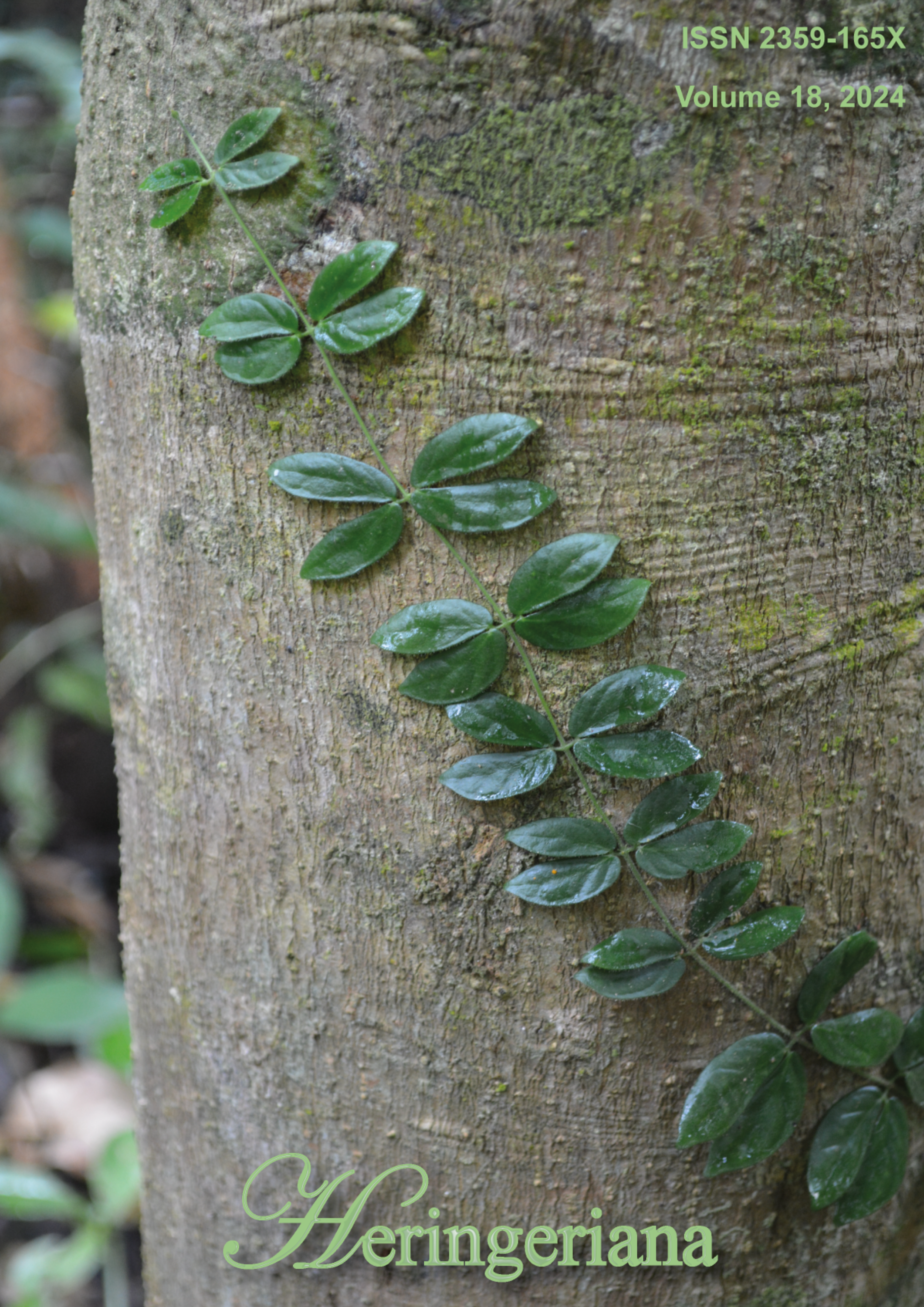Fidelidade de dormitório de tovacuçu, Grallaria varia Boddaert, 1783
DOI:
https://doi.org/10.70782/heringeriana.v18i1.918046Resumo
Este estudo investigou a fidelidade de dormitório do tovacucú (Grallaria varia) e os impactos da crescente população de javalis (Sus scrofa) em um ambiente natural. Realizado entre 2019 e 2020 na Serra da Mantiqueira, em São Paulo, o estudo observou um indivíduo de tovacucú roostando no mesmo local por 84 noites consecutivas. No entanto, após o aumento da presença de javalis, o pássaro deixou de ser registrado no dormitório. O aumento da população de javalis, que causa danos ao ecossistema, pode ter influenciado essa mudança. O estudo destaca a importância do monitoramento de espécies e dos impactos de invasores para a conservação da biodiversidade.
Referências
Alvares, C. A., Stape, J. L., Sentelhas, P. C., Gonçalves, J. D. M., & Sparovek, G. (2013) Köppen’s climate classification map for Brazil. Meteorologische zeitschrift 22(6): 711–728. https://doi.org/10.1127/0941-2948/2013/0507
Barrios-Garcia, M. N., & Ballari, S. A. (2012) Impact of wild boar (Sus scrofa) in its introduced and native range: a review. Biological invasions 14: 2283–2300. https://doi.org/10.1007/s10530-012-0229-6
da Rosa, C. A., Pinto, I. A., & Jardim, N. S. (2018) Controle do javali na Serra da Mantiqueira: um estudo de caso no Parque Nacional do Itatiaia e RPPN Alto-Montana. Biodiversidade Brasileira 8(2): 285–303.
Greeney, H. F., Dobbs, R. C., Martin, P. R., & Gelis, R. A. (2008) The breeding biology of Grallaria and Grallaricula antpittas. Journal of Field Ornithology 79(2): 113–129. https://doi.org/10.1111/j.1557-9263.2008.00153.x
Johnson, E. I., Stouffer, P. C., & Vargas, C. F. (2011) Diversity, biomass, and trophic structure of a central Amazonian rainforest bird community. Revista Brasileira de Ornitologia 19(1): 1–16.
Jirinec, V., Varian, C. P., Smith, C. J., & Leu, M. (2016) Mismatch between diurnal home ranges and roosting areas in the Wood Thrush (Hylocichla mustelina): Possible role of habitat and breeding stage. The Auk: Ornithological Advances 133(1): 1–12.
Jirinec, V., Elizondo, E. C., Rutt, C. L., & Stouffer, P. C. (2018) Space use, diurnal movement, and roosting of a Variegated Antpitta (Grallaria varia) in central Amazonia. Ornitologia Neotropical 29: 13–20.
Meireles, L. D., Kinoshita, L. S., & Shepherd, G. J. (2014) Composição florística da vegetação altimontana do distrito de Monte Verde (Camanducaia, MG), Serra da Mantiqueira Meridional, Sudeste do Brasil. Rodriguésia 65: 831–859. https://doi.org/10.1590/2175-7860201465403
Muscat, E., Rotenberg, E. L. & Tanaka, R. M. (2016) Sclerurus macconnelli may use roosting sites with high fidelity. Atualidades Ornitológicas 192: 27.
Muscat,E. & Tanaka, R. M. (2018) Nota sobre fidelidade de dormitório em Platyrhinchus mystaceus (Passeriformes: Platyrinchidae),São Francisco Xavier, São Paulo, Brasil. Atualidades Ornitológicas 203: 27.
Nanglu, K., de Carle, D., Cullen, T. M., Anderson, E. B., Arif, S., Castañeda, R. A., & Astudillo‐Clavijo, V. (2023) The nature of science: The fundamental role of natural history in ecology, evolution, conservation, and education. Ecology and Evolution 13(10): e10621 https://doi.org/10.1002/ece3.10621
Nunes, I., Guimarães, C. S., Moura, P. H. A., Pedrozo, M., de Toledo Moroti, M., Castro, L. M., & Muscat, E. (2021) Hidden by the name: A new fluorescent pumpkin toadlet from the Brachycephalus ephippium group (Anura: Brachycephalidae). PLoS One 16(4): e0244812 https://doi.org/10.1371/journal.pone.0244812
Risch, D. R., Ringma, J., & Price, M. R. (2021) The global impact of wild pigs (Sus scrofa) on terrestrial biodiversity. Scientific Reports 11(1):e13256. https://doi.org/10.1038/s41598-021-92691-1
Stouffer, P. C. (2007) Density, territory size, and long-term spatial dynamics of a guild of terrestrial insectivorous birds near Manaus, Brazil. The Auk 124(1): 291–306.
Tewksbury, J. J., Anderson, J. G., Bakker, J. D., Billo, T. J., Dunwiddie, P. W., Groom, M. J. & Wheeler, T. A. (2014) Natural history's place in science and society. BioScience 64(4): 300–310. https://doi.org/10.1093/biosci/biu032
Thiollay, J. M. (1994) Structure, density and rarity in an Amazonian rainforest bird community. Journal of Tropical Ecology 10(4): 449–481. https://doi.org/ 10.1017/S0266467400008154.
Thompson, M. E., Salicetti-Nelson, E., & Donnelly, M. A. (2022) ¿Dónde duermen las aves? Observaciones de aves descansando en el sotobosque de las tierras bajas de Costa Rica. Ornitología Neotropical 33(1): 53–57.
Downloads
Publicado
Como Citar
Edição
Seção
Licença
Copyright (c) 2024 João A. Bachur, Edelcio Muscat

Este trabalho está licenciado sob uma licença Creative Commons Attribution 4.0 International License.
Ao fazer a submissão, os autores declaram não ter submetido o trabalho a outra revista e concordam em ter seu artigo publicado sob Licença Creative Commons Atribuição 4.0 Internacional BY (CC BY 4.0), que significa que os autores mantêm a propriedade dos direitos autorais, mas qualquer pessoa pode usar o conteúdo publicado, desde que os autores originais e a fonte sejam citados. O conteúdo científico, ortográfico e gramatical é de total responsabilidade dos autores.








